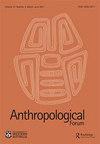‘Awakening the Stones’: The Nieri Performance, Gardens and Regeneration in Tanna, Vanuatu
IF 0.7
3区 社会学
Q3 ANTHROPOLOGY
引用次数: 4
Abstract
ABSTRACT In 2017, islanders from six villages on the southern island of Tanna, in the archipelago of Vanuatu, sculpted more than 50,000 taro into a large ship for the nieri, the premier Tannese exchange based on mythic injunctions to feed allies and protect land. Ships, canoes and stones are generative forms in Tanna and are woven into the interstices of daily life, gardens and ritual. This ritual, planned after the category 5 2015 Cyclone Pam destroyed gardens in Tanna, was also designed to ‘awaken the stones’ which ensure the fertility of gardens. The nieri reasserts the material and spiritual primacy of gardens through the exchange of food that engenders a particular kind of sociality and person in Tanna. During the performance, taro were swapped for yam from six coastal villages. Closely allied, taro and yam are gendered beings whose lives are entangled in the relational worlds of humans and other non-human beings. The fluid and ephemeral art forms that characterise Tannese ceremonial life are dependent upon and attuned to the cycle of the yam and taro garden. I explore how the ‘taro ship’ gathers the multiple relations and diversities that emanate from gardens. The nieri and the spectacle of taro ‘becoming’ ship, makes visible social, cosmological and ecological relations through the aesthetic forms that connect the everyday and myth.“唤醒石头”:瓦努阿图Tanna的Nieri表演,花园和再生
2017年,来自瓦努阿图群岛南部塔纳岛(Tanna)六个村庄的岛民将5万多芋头雕刻成一艘大船,以供涅里(nieri)之用。涅里是坦尼人的主要交换方式,以神话中的命令为基础,为盟友提供食物和保护土地。船、独木舟和石头是塔纳的生成形式,编织在日常生活、花园和仪式的间隙中。这个仪式是在2015年5级飓风帕姆摧毁了Tanna的花园后计划的,也是为了“唤醒石头”,确保花园的肥沃。nieri通过食物交换重申了花园在物质和精神上的首要地位,这在Tanna产生了一种特殊的社交和人。在演出期间,芋头被换成了来自六个沿海村庄的山药。芋头和山药紧密相连,是有性别的生物,它们的生活纠缠在人类和其他非人类的关系世界中。作为唐人仪式生活特征的流动和短暂的艺术形式依赖于山药和芋头花园的周期,并与之协调。我探索了“芋头船”是如何收集来自花园的多种关系和多样性的。nieri和taro“成为”船的奇观,通过连接日常和神话的美学形式,使社会,宇宙和生态关系可见。
本文章由计算机程序翻译,如有差异,请以英文原文为准。
求助全文
约1分钟内获得全文
求助全文
来源期刊

Anthropological Forum
ANTHROPOLOGY-
CiteScore
3.60
自引率
10.00%
发文量
14
期刊介绍:
Anthropological Forum is a journal of social anthropology and comparative sociology that was founded in 1963 and has a distinguished publication history. The journal provides a forum for both established and innovative approaches to anthropological research. A special section devoted to contributions on applied anthropology appears periodically. The editors are especially keen to publish new approaches based on ethnographic and theoretical work in the journal"s established areas of strength: Australian culture and society, Aboriginal Australia, Southeast Asia and the Pacific.
 求助内容:
求助内容: 应助结果提醒方式:
应助结果提醒方式:


